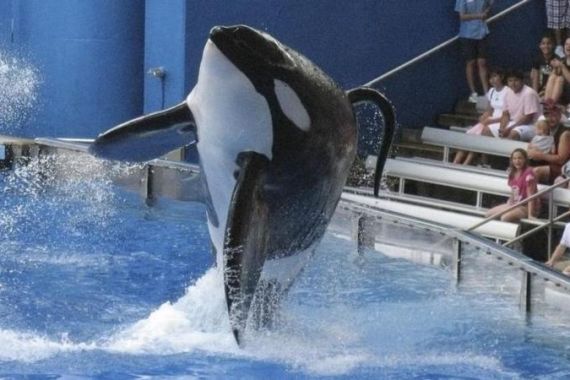Blackfish: Highlighting the plight of captive orcas
A new documentary follows the traumatic experiences of captive orcas as they undergo training and long careers in water

Blackfish, a riveting documentary about the deadly consequences of kidnapping orcas from the ocean and keeping them in captivity, is Sea World’s biggest nightmare. After a few successful months in theatres across the United States, it aired lastnight (Thursday, October 24) on CNN and will be released on DVD on November 12. Based on the haunting interviews with former SeaWorld trainers, scientists, and researchers, the film’s message is clear. These majestic creatures do not belong in captivity.
Profiteering from animal abuse
Kidnapping marine life from the ocean, removing them from their families, imprisoning them for life, and forcing them to perform tricks for people who pay $75 a ticket is not about educating the public as Sea World would have you believe; it’s all about profits. In October 2009, Anheuser-Busch announced plans to sell SeaWorld Orlando’s parent Busch Entertainment Corp (BEC) to the private equity firm Blackstone Group for $2.3bn. BEC operates 10 entertainment parks throughout the United States, including three SeaWorld parks in Orlando, Florida, San Antonio, Texas, and San Diego, California.
The purchase has been wildly successful for Blackstone. According to the Wall Street Journal, “Blackstone Group is going to keep reeling in the profits from its aquarium theme park.” When SeaWorld Entertainment went public with the help of Goldman Sachs on April 19, it sold 19.9m shares, netting a total of $505m. The Journal reports that the 20-cent per-share quarterly dividend will deliver Blackstone, SeaWorld’s majority owner, a cool $12m in cash every three months.
The good news is that SeaWorld’s stock is dropping and attendance is down. Hovering at $29.40 a share, its the lowest price since the company went public in April. When it reported financial results in August, Chief Financial Officer James Heaney said attendance fell nine percent in the second quarter.
This is what happens when the truth is exposed. I grew up going to marine parks and was in awe as I watched dolphins and orcas soar out of the water, fly through the air, and perform tricks. My family and I didn’t know that by paying to watch dolphins and orcas entertain us, we were contributing to their misery. We simply wanted to enjoy a day with our favourite sea creatures. I always thought the pools were too small, but I never thought about the animals’ living conditions or how they got there in the first place. When you learn the truth about how animals are captured and held, you are forever changed.
The orcas’ ordeal
John Crowe, a former diver, explains the kidnapping process in one of the most poignant interviews in Blackfish. In 1970, he was involved in a kidnapping operation in Puget Sound, Washington. When he and the other hunters tried to get the baby orcas into a stretcher, the family was in a big line communicating and refused to leave when their nets were removed. At that point, he realized he was kidnapping a child from its mother. On the verge of tears, he said it was the worst thing he’d ever done.
When the hunt was over, there were three dead whales in the net. Crowe and two others cut the bodies open, filled them with rocks, put anchors on the tails, and sank them.
Orca hunters were ejected by the state of Washington in 1976. The order specifically told SeaWorld to stop capturing killer whales, so they went from Washington to Iceland and began capturing there.
In 1983, a male orca was captured in the North Atlantic. At two years of age, he was already 11.5 feet long. His captors named him Tilikum. A number of Tilikum’s trainers speak candidly in Blackfish about his miserable life at Sealand in Victoria, Canada. When he was just four years old, he was 16-feet-long and weighed 4,000 pounds. Former Sealand trainers said Tilikum and two other orcas were locked in a 20-by-30 foot dark metal container for two-thirds of their lives. There was no stimulation, they were mostly immobile for 14 hours a day, and the trainers punished and deprived them of food in order to make them perform tricks.
The physical trauma, coupled with the emotional distress of being taken from his family and home, took a major toll on Tilikum, pushing the animal to aggression.
In 1991, Tilikum killed trainer Keltie Byrne. On February 24, 2010, Tilikum brutally attacked and killed veteran SeaWorld Orlando whale trainer Dawn Brancheau. After Brancheau was killed, there was a major change in media coverage. Former insiders went on national television saying orcas should not be held captive, which got the public thinking about the negative and sometimes deadly effects of removing all captive animals from their natural environments, both in and out of the water.
If you want to stop this brutality, refuse to go to water parks. Don’t buy a ticket. See the film and spread the word. We now know too much to allow this to continue.
Rose Aguilar is the host of Your Call, a daily call-in radio show on KALW in San Francisco.
Follow her on Twitter: @roseaguilar
